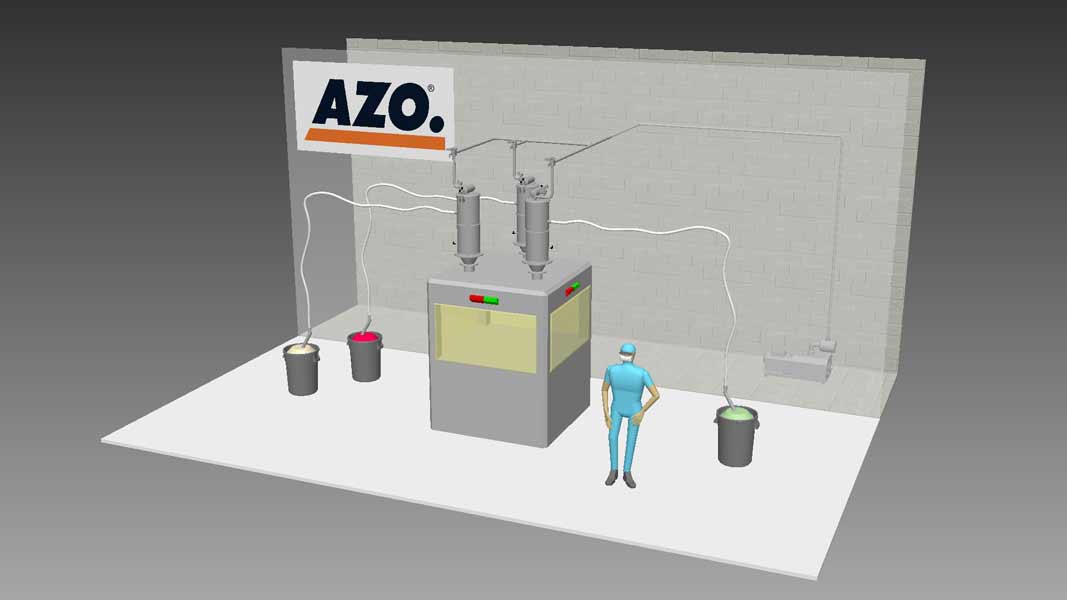







Nowadays in the pharmaceutical industry, tablets and capsules are produced inside very clean production areas called clean rooms, fulfilling the highest of hygienic standards. These clean rooms are kept as small as possible, not only because of their initial investment, but also because clean and conditioned air is necessary for pharmaceutical production in the production area.
Optimal utilization of the clean production area is a must to enhance the use of invested capital and to limit operational costs. As a result, tablet presses and capsule fillers are commonly designed very compactly. For AZO, This means that the space allowed for the feeding tablet presses with semi finished products is very limited. Often, there is not sufficient space to lift a container on top of the tablet press or capsule filler. As a result, AZO provides vacuum conveying feed systems for gently feeding the tablet press or capsule filler with semi-finished products.
This also means that it is not mandatory to feed the filling machines by means of a lifting column, i.e. lifting containers up, rotating and placing the container on top of them. Depending on our customer’s manufacturing process and thus internal packaging, we have different possibilities of feeding the tablet presses and capsule fillers with semi finished product.
Most common is to take the semi finished products by means of an operator controlled suction nozzle. This working method allows for using a wide range of internal packaging like drums, buckets or any other kind. The vacuum conveying principle is a low velocity system for gentle conveying of powders, granules and empty capsules.
We also have the know-how and solutions to accept the semi-finished product out of containers by means of container discharge stations. Because of a constant product flow to the product pick up point, we can use our vacuum impulse conveying system to ensure a most gentle and segregation free handling of the powders, granules or empty capsules.
Dense-phase conveying is the optimal solution for segregation free conveying as products are conveyed in a pipe gently packed together with air pulses in between. A statement from a customer says: "Extensive trials concerning the segregation of ingredients with direct tableting blends prior to the investment decision convinced us that vacuum impulse conveying method was the firstchoice for feeding tablet presses."
By means of a vacuum receiver, the mixed semi finished product is gently conveyed out of a bin or a container from the floor level, into a small buffer hopper at the tablet press or capsule filler, as already described above. The receiver is connected to a vacuum pump that builds up vacuum within the receiver. The receiver is equipped with a customizable filler to separate dust from the conveying air. This ensures long pump life and efficiency. By flushing the filler with compressed air, the fillers don't clog and the product remains within the process system. Thus, the whole production area stays dust-free and clean. Click here for more information regarding dense-phase vacuum conveying.
Dense-phase conveying is the optimal solution for segregation free conveying as products are conveyed in a pipe gently packed together with air pulses in between. A statement from a customer says: "Extensive trials concerning the segregation of ingredients with direct tableting blends prior to the investment decision convinced us that vacuum impulse conveying method was the firstchoice for feeding tablet presses."
Dense-phase and low-velocity vacuum conveying is a proven technology with very short downtimes as no moving parts are involved in the process except the vacuum pump. Vacuum pumps are well known for their durability; If desired, the system could still be designed with a redundant pump. As a matter of fact, with very short downtimes of the feeding process, the efficiency of the tablet press or capsule filler can be optimized.
For the operator, the handling is very easy: Only the bins need to be placed near the tablet press or capsule filler, respectively the container will be placed on the container discharge station. The operator does not get in contact with the semi-finished product, meaning that there is no contamination caused by operator handling. After the bin is placed, the operator inserts the suctionnozzle into the bin or container and activates the process by pressing a button. The feeding process will then start and (after optimum adjustment during the commissioning phase) the receiver will suck the right amount of semi-finished product to the filling machine to ensure a reliable tableting or capsule filling process. The operator has to make sure that the suction nozzle has always enough material at the pick up point.
When the semi finished product is delivered in containers, the operator is just placing the container on the container discharge station and will also not be in contact with the product. Thus we can guarantee for product and operator safety by eliminating any risk of contamination completely. He then only has to supervise the conveying process and has to make sure the containers will be changed and replaced when empty.